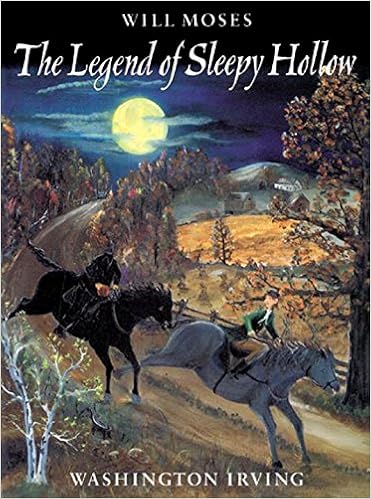
Description
From Publishers Weekly Paintings by Grandma Moses's great-grandson make a striking match for Irving's classic story of strange goings-on in a small town in the Hudson Valley. Though greatly condensed, the plot remains intact; Ichabod Crane, the gangly schoolteacher, is driven out of Sleepy Hollow by a pumpkin-headed horseman who may (or may not) have been his flesh-and-blood rival to the affections of Katrina, a well-off young beauty. The paintings-naive, bright and straightforward in the tradition associated with Moses's illustrious forebear-suit the story stylistically although they do not fully enter into its spirit; they do not vary to plumb the moods of the story, which range from low country comedy to romance to suspense and terror. But the illustrations are well placed, either as two-page set pieces of the churchyard or Katrina's family farm (these are strikingly similar in composition to the work of Grandma Moses), or as small vignettes amidst the text. Overall, an attractive illustrated storybook, which may excite interest in the original. Ages 6-up. Copyright 1995 Reed Business Information, Inc. From School Library Journal Grade 3-6?Unlike the more concise adaptations by Robert Van Nutt (Rabbit Ears, 1991) and Robert San Souci (Doubleday, 1986), this version of the classic tale, retold by Grandma Moses's great-grandson, remains true to the original in its lengthy and flowery narration. An unnamed storyteller enthusiastically relays the legend of the Headless Horseman and his effect on the schoolmaster, Ichabod Crane, in "...a mysterious, dreamy little settlement called Sleepy Hollow." While there are occasional awkward passages, the text is lively and compelling, with a 19th-century flavor. The primitive paintings enhance the Hudson Valley setting; unfortunately, their quality is uneven. Moses is most successful with the double-page landscapes and village scenes (similar to his great-grandmother's style), which will intrigue readers with their detailed activity. A few of the smaller vignettes capture humorous situations and the personalities of individual characters, but many, especially the night scenes, are indistinct and muddy. Moses includes black characters in the illustrations, though he has removed Irving's stereotyped descriptive passages. The lively text begs to be read aloud, but the detailed paintings lend themselves to one-on-one viewing. Try San Souci's or Van Nutt's version if you are sharing the illustrations with a group.?Kristin Lott, East Brunswick Public Library, NJCopyright 1995 Reed Business Information, Inc. From Booklist Gr. 3^-5. Many folk-art paintings illustrate this simplified retelling of Washington Irving's Legend of Sleepy Hollow . Varied in size from small vignettes to double-page spreads, the colorful paintings are reminiscent of the works of Moses' great-grandmother, better known as Grandma Moses. A large-format picture book that will fill a need in some libraries. Carolyn Phelan Washington Irving , one of the first American authors to earn his living from writing, was born in 1783 and died in 1859. Painting is as much a part of the Moses family tradition as the family homestead in Eagle Bridge, New York. There Will Moses has painted since he was a little boy, learning firsthand from his grandfather, folk artist Forrest Moses, who learned from his mother, Anna Mary Robertson Moses, better known as Grandma Moses. Developing his own folk style, Will has become an internationally beloved artist in his own right, his work displayed in collections throughout the world, including that of the White House. His folk art can also be foundxa0in such books as The Night Before Christmas, Will Moses' Mother Goose, and Mary and Her Little Lamb . Read more
Features & Highlights
- Washington Irving's classic tale of romantic schoolmaster Ichabod Crane and his terrifying encounter with the Headless Horseman is given new life in this edition, featuring the richly detailed, one-of-a-kind folk illustrations of Will Moses.





